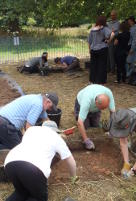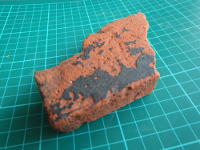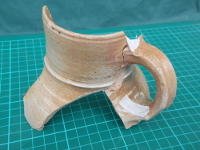16 Jul 2015
Festival Of Archaeology 2015 - Forty Hall - Day 3

Another day of mixed fortunes in Forty Hall, on the third day of our Festival of Archaeology dig in search of part of the Tudor Palace of Elsyng.
Since trench one has now shown definitively no signs of any substantial structure, Historic England, who visited us today, kindly approved a change in strategy. We have moved back towards the lime tree avenue, closer to last year's trench and opened two small test pits on the alignment of the building we are after.
Frustratingly, there is still no obvious wall emerging from the ground -- the structure we uncovered last year was very substantial and shallowly buried so it should be hard to miss when we do find it.

The pit closest to the avenue, and only a couple of metres from last year's trench is so far looking very promising -- there is a block of in-situ brickwork in its corner, although it looks to be too insubstantial to be the wall we're after -- it may be an internal feature within the building, which in itself would be excellent news.
The pit is also producing a lot of rubble and quite a few very nice finds, including part of a glazed floor brick (pictured), which once may have been part of a chequer-board pattern within our target building.

We have also found small fragments of window lead and even a few pieces of window glass and several large pieces of a splendid stoneware pitcher (pictured).
We found a similar vessel last year, decorated with oak leaves and acorns, which would have been imported from Cologne in the sixteenth century, though this one appears to be undecorated and has not yet been accurately dated.
{{ rthumb(src="fba-els-15/pipe", alt="tobacco pipe", caption="clay tobacco pipe" }}
The smallest find to come from the pit was a small fragment of a decorated Venetian glass vessel, quite late in the day (so no picture yet -- stay tuned). It's only the second such fragment ever found at Elsyng and would have been an expensive import, and a very prestigious item in its day.
Just before we finished working in trench one, it produced an almost complete clay tobacco pipe, probably dating from the late sixteenth century. We've almost finished excavating and recording trench one, and will probably begin to backfill it tomorrow, and concentrate our efforts on our two test pits.
If there is still no sign of our wall in the area closest to the avenue, we may find that the wall sharply changes direction very close to where we excavated it last year -- one way or the other we ought to find out tomorrow.
We still have three days to go, and we're determined to get to the bottom of the mystery of the vanishing wall before the week is out!